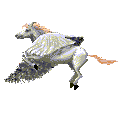
1.
Brugmann (1888), II, 103-42.
Ryan (1990)3.
Edel (1955/64), I, 57: "Der Laut l, den das Ägyptische nach Ausweis des Koptischen besessen haben muß, wird durch verschiedene Zeichen und Zeichenkombinationen ausgedrückt: 1. Durch n in ns20'Zunge` PT 1306 cP. für *ls, wie S. las und die semitischen Formen (z. B. akk. liš-ânu) zeigen..."214.
I prefer to designate this Sumerian phoneme as g~~ to distinguish it from g~ which derives from Proto-Language f(hy)e.5.
Similarly, I prefer to differentiate Sumerian ñ and k~ from Proto-Language ngh from Sumerian n and k from Proto-Language n(h)-/w, and kx?/kxh.6.
From phé, 'mouse`; this form actually occurs in PIE as pel- in Latvian pele, 'mouse`, listed under 6. pel- in Pokorny (1959): 804-805; and in Egyptian pn.w, 'mouse (really 'mice`); cf. also Arabic fa?run, 'rat, mouse`, with different formants ['tunneler??`]. Sumerian *mûn, *testicle, *man`, has probably been suppressed by mûn(u)(-2/3), 'salt` (PL "mhó na, 'pond stone = salt`7.
Compare also PIE me:-no-, 'measure`. That these words should be reconstructed with initial ?e- is shown by Proto-Semitic ?mm in Hebrew ?amma:, 'ell, cubit` and ?mt, 'determine, conjecture`, equivalent to PIE 1. me/e:d-, 'measure, consider`; PIE e:in this word is due to the initial combination ?m-. There are some reasons to consider the Egyptian god Amen as a personification of the moon, 'the measurer`, Amen being a fuller form of Min.8.
Greek é:, interrogative particle, and ê:, what?, pray?, can it be...?; Arabic ?a-, interrogative particle {prefix} (sentence initial); Chinese á, interrogative particle (sentence final); and in Latin an(ne), interrogative particle, listed under 2. an, 'there, on the other hand`9.
-w, is seen in combination in PIE 4. au- 'that` (PL ?áfw = ?á, 'forehead, place of focus` + f, 'ear; place of hearer, there`)10.
-f; PIE (a)po(s)-, 'behind` (PL phó, 'toad, puff up, turgid penis, male, he, place of him spoken about, over there`)11.
-3; (PL ré, 'scratch, any`; indefinite inanimate singular)12.
-i; PIE e, 'there` (PL ?é, 'eye; place of spoken about, over there`)13.
-ii; PIE ei, 'there` (PL ?é¿, 'eye(s/-like`)14.
Proto-Language had a definite animate plural in -fhá and a definite inanimate plural in -fa, 'palm, number, leaf`.The reflexes of -fha in PIE are -wa:/-u:/-V:u(w); in Egyptian, -w; in Proto-Semitic, -wâ/-û; and in Sumerian, -û. The reflexes of -fa in PIE are -wa/-u/-Vu; in Egyptian, -w; in Proto-Semitic, -wa/-u; and in Sumerian, -u.
We can see the Proto-Language definite animate plural in the PIE dual nominative-accusative-vocative ending of masculine-feminine (animate) o-stems, -o:u.
For Afro-Asiatic, the ending of third person plural form of the Arabic verb, -u:, and of the Egyptian verb, -w (late for the sdm.f form but fairly regularly for the Old Perfective), shows that a definite plural was the original meaning of reflexes in PL -fhá, not the dual!
In both Egyptian and , the earliest writings of plural nouns by tripling the signs or determinatives (or three strokes or dots in Egyptian) are the representation of indefinite plurals in Proto-Language -H(á) or -¿(á). These were both preposed and postposed. Postposition had only the effect of lengthening the final vowel of the word in Egyptian.
In Egyptian, when the Proto-Language definite plurals -fh(á)/f(á) began to be used in place of the indefinite plurals perhaps for the purpose of providing a phonetically more prominent contrast the word wi (PL fá), properly 'number-like, pair` was introduced as a suffix to indicate the dual.
That Egyptian -wi by itself meant 'pair, two, twice` is buttressed by its employment as an admirative in phrases like nfr.wi!, 'how beautiful!` (really 'twice beautiful!`); and PIE, where we have, of course, 1. wi/i:-, meaning 'two` (cf. also phrases like Modern German wie schön ist...!).
For Proto-Language, we cannot assume a dual form as Lehmann (1974) and others have
recognized for PIE, and I would add: except insofar as it corresponds to a definite plural.
15.
Because of the great time-depth and the paucity of early sources, nothing can ever be simple and straightforward in Egyptian or Sumerian studies, only probabilities can be proposed.
A scenario which may explain the doubled 'arms in gesture of negation` for the negative is:
a. though PL t? was 'arm` (Egyptian ', 'arm`; Sumerian ta-2, '*arm` / da, '*hand`/'side` [from PL
t?á], which pictures a right hand with arm), another term, ?á, 'plant-top`, developed the more
generalized meaning 'stalk`, and later 'limb`; thus, we have a Sumerian sign (Jaritz 1967: Sign
628) which pictures an arm + grain (perhaps additionally motivated by PL ¿á, 'tooth, seed`),
which reads a-2, and means 'arm, side, strength (PL há, 'air, "wind", strength`). This is a clever
graphic device for indicating a pronunciation of /a/ (from PL ?á, 'plant-top, limb`) for the idea of
'arm`, shown below.

b. An Old Egyptian negative is w; and in view of the relative negative iw.t(i)(i), common at all periods, we assume w is a reduction from *iw (PL ¿èf, mentioned above).
c. Because of the use of the sign 'forearm with palm of hand downwards` as a determinative with
ni, 'reject`, we assume that this sign

had an original reading of i, representing PL ?á; and since Egyptian i reflects PL ?/¿, also represented PL ¿è, 'take away`. Doubled, it could represent ?áf, 'pair of limbs`, or &191èf, 'taken away`. The variations between definite plurals in -w and indefinite plurals in *-i/i- allowed doubled signs to be read as S + -w as well as i- + S. Because of the relatively infrequent employment of the 'forearm with palm of hand downwards`, its doubled form, seen altered above in the Egyptian negative, was mistakenly changed to a doubled 'forearm` with the palms oriented upwards rather than downwards, the form we actually find.
d. Representing an original iw ideationally rather than phonetically, it easily acquired the reading
in when this negative supplanted iw.
16.
![]()
additional copies of this file are available at
HTTP://WWW.GEOCITIES.COM/Athens/Forum/2803/PERSPRO3A-Notes.htm

Patrick C. Ryan * 9115 West 34th Street - Little Rock, AR 72204-4441 * (501)227-9947
PROTO-LANGUAGE@email.msn.com